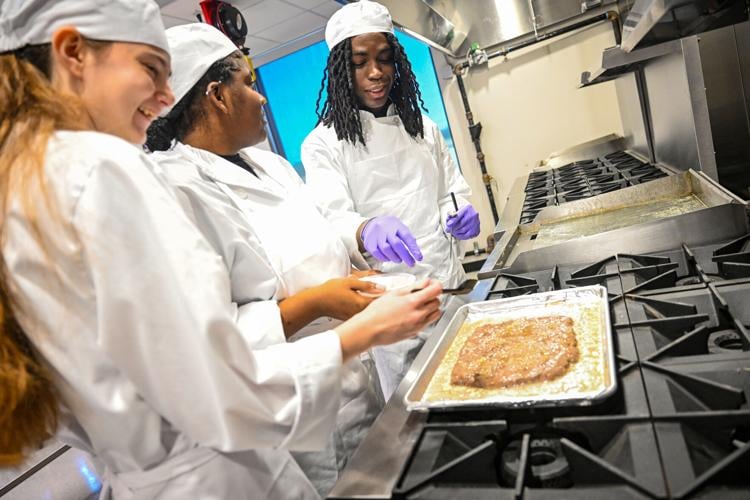The culinary classroom at the West Baton Rouge Academy smelled like a summer cookout.
Students pressed sautéed onions into trays of ground beef and sliced American cheese to put on top of sliders. Other kids were in charge of milkshakes. They lugged gallons of cookies ân cream and vanilla ice cream and slammed them onto stainless-steel counters to scoop into blenders.
Not all of the students will go into the culinary field. But hands-on classes like this one at the school, which opened last month, offer students a chance to explore their interests and become more prepared for the workforce, academy coordinator Jill Edwards said.
âWeâre offering this to prepare the kids to find a career â a good career,â Edwards said. âAll these (industries) need these people. We can get them ready for the workforce and provide a workforce on this side of the river for our kids and industry partners.â
West Baton Rouge Career Academy, located next to Port Allen High School, opened this school year to give high school students from Port Allen and Brusly access to expanded career and technical learning opportunities. Students can try their hand at a variety of careers â from cosmetology to welding, from robotics to medical assistance.

Electrical student Abari Smith nails electrical boxes to the frame of a model room while other students work on their laptops at West Baton Rouge Career Academy on Thursday, November 14, 2024.
The academy is one approach on a community level to tackling . The state will need 35,000 more skilled craftworkers in the next several years, the Greater Baton Rouge Industry Alliance estimated.
Like the rest of the state, the Westside also needs more people entering the trades, Edwards said.
âOur industry partners are [saying] we need welders, we need carpenters, we need construction workers, we need all these services,â Edwards said. âBut the training just wasnât here.â
Inside the career academy
Before career and technical students had their own building, they took classes through a partnership with the Westside campus of Baton Rouge Community College.
Candice Breaux, Career Technical Education supervisor for West Baton Rouge Parish schools, said she is excited to be able to provide students with a dedicated space, an opportunity that is sometimes only available in wealthier districts.
âThe chance for them to see whatâs out there and for them to be able to leave high school â knowing they still need to get some more training, but still be able to get into the field theyâre interested in and begin that process and be a step ahead of some other students â is really important for our students in West Baton Rouge,â Breaux said.

Student Blair Barbay smiles as she picks up a new hair styling technique after receiving help from cosmetology instructor Ameerah Jenkins at West Baton Rouge Career Academy on Thursday, November 14, 2024.
Students also expressed their enthusiasm for the new building. Many are just starting with the hands-on aspects of their classes as supplies continue to be delivered and they complete safety trainings.
Taking the classes helps students more thoroughly understand their potential careers, junior Jayden Nette said.
âYou get a taste to see if itâs something you really want to do,â Nette said.
Some kids have pivoted after gaining firsthand experience with a career, Edwards said. One student switched from welding to cosmetology.
âWhen you have something like this available, you can really explore all your interests,â Edwards said.
The building sees more than 200 students every week on a block schedule. The most popular classes are welding and electrical, according to Edwards.

Certified Clinical Medical Assistant student Leighann Saurage looks at a birthing simulation as she controls the virtual cadaverâs orientation at West Baton Rouge Career Academy on Thursday, November 14, 2024.
The facilities are brand-new and high-tech, made possible by a $1.2 million grant. In the medical assistance class, the students use a life-size touchscreen device to learn about the human body. Five unique cadavers are programmed into the device, and the students can tap a bone, muscle or organ to learn about its function.
As the academy grows, Edwards hopes to add more careers into their offerings, such as a millwright class.
âWeâre trying to think of anything, anything at all, that would help expand the programs,â Edwards said. âAs our industry partners show us interest, we can look into finding instructors for those courses and just offer as much as we can.â





